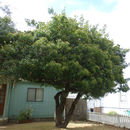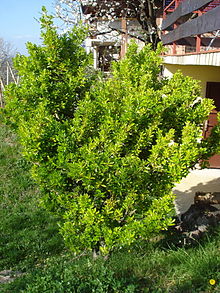zh-TW
在導航的名稱


Yapon gərməşovu
Yaponiyada, Qafqazda yayılmışdır.
Hündürlüyü 4-8 m olan həmişəyaşıl ağac və ya koldur. Cavan budaqları dörtdilli, qabığı qonurumtul-yaşıldır. Yarpaqları dərivarıdır, üst tərəfdən parlaq, tünd-yaşıl, altdan isə nisbətən solğun rəngdədir. Qaidə hissəsi pazvarı, kənarları oyuqvarı dişlidir. Aprel-may aylarında çiçəkləyir. Çiçəklərinin sayı 10-40 ədəd olub, yarımçətirli çiçək qrupunda yerləşir. Meyvəsi oktyabr-noyabr aylarında yetişir.
Gilli, qumsal torpaqlarda yaxşı bitir, şaxtaya, istiyə davamlıdır. Dəniz səviyyəsindən 1800 m hündürlüyə qədər olan meşələrdə seyrək hallarda bitir.
Bu növ Böyük və Kiçik Qafazda, Cənub bölgəsində yayılmışdır. Respublikanın bütün rayonlarında mədəni şəraitdə park və bağlarda rast gəlinir.
Dekorativ bitki kimi yaşıllaşdırmada geniş istifadə olunur.
Yapon gərməşovu
L'Evònim del Japó (Euonymus japonicus) és una espècie de planta amb flor, originària del Japó, Corea i la Xina, de la família de les Celastràcies.
Es tracta d'un arbust de fulla persistent o un petit arbre que pot arribar a fer de 2 a 8 m d'alt. Les fulles són de disposició oposada i ovals, fan de 3 a 7 cm de llarg i estan finament serrades. Les flors són poc vistoses de color blanc verdós. A la tardor presenta fruits de color taronja. És una planta ornamental molt popular tant dels llocs on és originari com a Amèrica del Nord; nombrosos cultivars s'han seleccionat, sovint amb fulles grogues o variegades.
Llwyn a phlanhigyn blodeuol yw Piswydden fythwyrdd sy'n enw benywaidd. Mae'n perthyn i'r teulu Celastraceae. Yr enw gwyddonol (Lladin) yw Euonymus japonicus a'r enw Saesneg yw Evergreen spindle.[1] Ceir enwau Cymraeg eraill ar y planhigyn hwn gan gynnwys Piswydden Fythwyrdd.
Tyf mewn ardaloedd o hinsawdd tymherus.
Llwyn a phlanhigyn blodeuol yw Piswydden fythwyrdd sy'n enw benywaidd. Mae'n perthyn i'r teulu Celastraceae. Yr enw gwyddonol (Lladin) yw Euonymus japonicus a'r enw Saesneg yw Evergreen spindle. Ceir enwau Cymraeg eraill ar y planhigyn hwn gan gynnwys Piswydden Fythwyrdd.
Tyf mewn ardaloedd o hinsawdd tymherus.

Euonymus japonicus (evergreen spindle[1] or Japanese spindle) is a species of flowering plant in the family Celastraceae, native to Japan, Korea and China.[2][3] It is an evergreen shrub or small tree growing to 2–8 m (6 ft 7 in – 26 ft 3 in) tall, with opposite, oval leaves 3–7 cm long with finely serrated margins. The flowers are inconspicuous, greenish-white, 5 mm diameter. In autumn, orange fruit hangs below the flaring pink seed coverings.
Euonymus japonicus is a popular ornamental plant for parks and gardens, both in its native area and also in Europe and North America. In particular the numerous cultivars which have been selected (often with variegated or yellow leaves) are widely grown in all soil types in sun or shade. Some of the more distinctive cultivars are:
(those marked agm have gained the Royal Horticultural Society's Award of Garden Merit)[7]
 A variegated Cultivar in early springtime
A variegated Cultivar in early springtime Euonymus japonicus (evergreen spindle or Japanese spindle) is a species of flowering plant in the family Celastraceae, native to Japan, Korea and China. It is an evergreen shrub or small tree growing to 2–8 m (6 ft 7 in – 26 ft 3 in) tall, with opposite, oval leaves 3–7 cm long with finely serrated margins. The flowers are inconspicuous, greenish-white, 5 mm diameter. In autumn, orange fruit hangs below the flaring pink seed coverings.
Euonymus japonicus, el huso japonés, el bonetero o el evónimo es una especie nativa de Japón, Corea y China.
Es un arbusto perenne o pequeño árbol que alcanza 2-8 m de altura. Las hojas son ovaladas de 3-7 cm de largo, finamente serradas. Las flores son discretas de color verdoso-blanco de 5 mm de diámetro.
Euonymus japonicus fue descrita por Carl Peter Thunberg y publicado en Nova Acta Regiae Societatis Scientiarum Upsaliensis 3: 208. 1780.[1]
Euonymus: nombre genérico que viene de las palabras griegas eu = "bueno", y onoma = "nombre".[2]
japonicus: epíteto geográfico que alude a su localización en Japón.
Euonymus japonicus, el huso japonés, el bonetero o el evónimo es una especie nativa de Japón, Corea y China.
Basaerramu japoniarra (Euonymus japonicus) Japonia, Korea eta Txinan jatorria duen Euonymus generoko espeziea da. Garaiaz 2 eta 8 m artekoa izaten den zuhaixka edo zuhaitz txiki bizikorra da, 3-7 cm luze diren eta ertzak modu finean zerratuak dituzten aurkako hosto obalekin. Loreak, 5 mm-ko diametrokoak, berde zurixkak dira eta ez dira asko nabarmentzen. Udazkenean, laranja koloreko fruituak agertzen dira eskegita, hazi estalgarri gorrizta nabarmenen azpian.
Lorategietan eta, askotan erabiltzen den landare apaingarria da, bai bere jatorrizko eremuan eta bai Europa eta Ipar Amerikan; baratze-barietate anitz aukeratu dira, askotan kolore horiko edo kolore bat baino gehiagoko orriekin.
Euonymus japonicus 'Aureo-marginatus', Basaerramu japoniarraren baratze-barietatea
Laakerisorvarinpensas eli sorvarinlaakeri (Euonymus japonicus) on sorvarinpensaiden sukuun kuuluva laji. Se kuuluu kelaskasvien heimoon.
Lehdet sijaitsevat vastakkain. Laakerisorvarinpensaan eräällä lajikkeella on keltareunaiset lehdet.
Laakerisorvarinpensas on kotoisin Japanista.
Laakerisorvarinpensasta käytetään huonekasvina.[1] Kasvi tarvitsee vettä runsaasti. Se kestää hyvin leikkausta ja sitä voi lisätä pistokkaista.
Laakerisorvarinpensas eli sorvarinlaakeri (Euonymus japonicus) on sorvarinpensaiden sukuun kuuluva laji. Se kuuluu kelaskasvien heimoon.
Fusain du Japon
Euonymus japonicus ou fusain du Japon est une espèce de plante du genre Euonymus et de la famille des célastracées. C'est un arbuste à feuillage persistant, originaire du Japon qui est à l'origine de formes cultivées introduites dans de nombreuses régions tempérées du monde[1].
Euonymus est dérivé du grec ευ eu « bien » et ονομαζω onomazô « nommer », soit « au nom de bon augure » par antiphrase. Le genre Euonymus a été créé en 1753 (Spec. Plant.) par Carl Linné. Il était déjà employé par l'encyclopédiste romain Pline (H. N., 1, 13, 38; 13, 118) pour désigner peut-être le fusain[2] ou, le terme convenant mal, le Rhododendron flavum L.
L'épithète spécifique japonicus « du Japon » a été employé par le médecin et botaniste suédois Thunberg, le premier botaniste européen à se rendre au Japon en 1775-1776 où, souvent au prix de grands dangers, il réussit à collecter des spécimens de plantes et d'animaux.
Le fusain du japon est un arbuste à feuillage persistant, pouvant atteindre 3 m de haut, aux rameaux verts, térètes (cylindriques), glabres.
Le feuillage est persistant. Les feuilles opposées comportent un pétiole de 3 à 10 mm et un limbe vert foncé, coriace, brillant, obovale à elliptique, en général de 5-10 x 3-5 cm[1], avec une marge finement dentée en scie (sauf à la base).
L'inflorescence est une cyme unipare en général axillaire parfois terminale, sur les pousses de l'année, avec un pédoncule allant jusqu'à 8 cm, des sous-branches et des pédicelles (4-6 mm). Elle porte une fleur 4-mère, de 5-6 mm de diamètre, de 4 sépales et 4 pétales (verts, jaunâtres ou crème), parfumée, nectarifère.
En France, la floraison a lieu en juin-juillet[3].
Le fruit est une capsule globuleuse, jaune brunâtre lavé de rose, pourvue d'arille rouge corail, toxique, à 4 carpelles contenant chacun 2 graines noirâtres.
Euonymus japonicus est très semblable à E. fortunei (plus largement répandu en Asie orientale), sa forme sauvage est de port érigé, étalé, alors que E. fortunei est de port grimpant ou procombant.
Son aire d'origine est le Japon[1].
Il est cultivé en Chine, Inde, Pakistan, Asie du sud-est, Indonésie, Philippines, Europe et Amérique tempérées[4].
Il a été introduit en Europe vers 1800 et a depuis été fréquemment utilisé pour confectionner des haies mono-espèce dans les parcs et jardins[3].
Le fusain du Japon est un arbuste à feuillage toujours vert, très apprécié des architectes paysagistes pour établir des haies de jardins bien compactes et supportant bien les tailles sévères.
Il trouve aussi sa place en potée sur un balcon ou une terrasse. Il faut alors choisir une variété à faible développement comme E. japonicus 'Arlequin'.
Il n'est pas très exigeant pour le type de sol et résiste bien à la pollution urbaine et au gel. Il supporte d'être planté à l'ombre[3], du début de l'automne jusqu'au mois de juin. Il est, par contre, sensible à l'oïdium et aux cochenilles du fusain (Unaspis euonymi) et peut subir l'attaque de chenilles défoliatrices (Yponomeuta cognagella)[3].
La taille s'effectue au printemps. En culture, l'arbuste peut atteindre 4 m de haut.
Il existe de nombreux cultivars à feuillage panaché
etc.
Jeune rameau, juin (Corée)
Euonymus japonicus 'Microphyllus', cultivé en remplacement des bordures de buis ravagées par la Pyrale du buis
Fusain du Japon
Euonymus japonicus ou fusain du Japon est une espèce de plante du genre Euonymus et de la famille des célastracées. C'est un arbuste à feuillage persistant, originaire du Japon qui est à l'origine de formes cultivées introduites dans de nombreuses régions tempérées du monde.
Japanski kapralc (Euonymus japonicus) je rostlina ze swójby kapralcowych rostlinow (Celastraceae).
Japanski kapralc je šěroko rosćacy, přeco zeleny kerk, kotryž docpěje wysokosć wot něhdźe 3,5 m.
Ćmowozelene łopjena su błyšćace.
Kćěje w zažnej lěću. Kćenja su swětłozelenojte.
Płody su blědźe róžojte kapsle. Symjenja su oranžowe.
Pochadźa z Japanskeje.
« Japanski kapralc » w druhich wikimediskich projektach :
Japanski kapralc (Euonymus japonicus) je rostlina ze swójby kapralcowych rostlinow (Celastraceae).
Euonymus japonicus (Thunb., 1780), noto anche come mandrino sempreverde o mandrino giapponese, è una pianta angiosperma della famiglia delle Celastraceae, originaria del Giappone, Corea e Cina.[2][3] L'epiteto specifico japonicus, "giapponese", deriva dal latino e si riferisce alla provenienza della specie.[4]
È un arbusto sempreverde, talvolta alberello, che cresce fino a 2–8 m di altezza, con foglie ovali opposte lunghe 3–7 cm con margini finemente seghettati. I fiori sono di piccole dimensioni, di colore verde-bianco, di 5 mm di diametro. In autunno il tegumento rosa dei semi si apre e da esso fuoriescono i frutti arancioni, che pendono dall'involucro.
Euonymus japonicus è una pianta ornamentale molto diffusa per decorare parchi e giardini nella sua zona di origine ma anche in Europa e nord America. In particolare le numerose cultivar che sono state selezionate (spesso con foglie gialle o variegate) sono ampiamente coltivate in tutti i tipi di terreno, sia al sole che all'ombra.
(Le cultivar con il simbolo GM sono contrassegnate dal premio Garden Merit assegnato dalla Royal Horticultural Society's[7])
Euonymus japonicus (Thunb., 1780), noto anche come mandrino sempreverde o mandrino giapponese, è una pianta angiosperma della famiglia delle Celastraceae, originaria del Giappone, Corea e Cina. L'epiteto specifico japonicus, "giapponese", deriva dal latino e si riferisce alla provenienza della specie.
È un arbusto sempreverde, talvolta alberello, che cresce fino a 2–8 m di altezza, con foglie ovali opposte lunghe 3–7 cm con margini finemente seghettati. I fiori sono di piccole dimensioni, di colore verde-bianco, di 5 mm di diametro. In autunno il tegumento rosa dei semi si apre e da esso fuoriescono i frutti arancioni, che pendono dall'involucro.
Euonymus japonicus là một loài thực vật có hoa trong họ Dây gối. Loài này được Thunb. mô tả khoa học đầu tiên năm 1780.[1]
Euonymus japonicus là một loài thực vật có hoa trong họ Dây gối. Loài này được Thunb. mô tả khoa học đầu tiên năm 1780.
冬青卫矛(学名:Euonymus japonicus)亦称绿篱卫矛、日本卫矛、大叶黄杨、正木等,为卫矛屬植物。供观赏,常植为绿篱。
为常绿灌木,叶子对生,常是倒卵形,并有钝锯齿,上面深绿色、光亮;夏季开绿白色小花,聚伞花序;扁球形裂开果实;种子有橙色假种皮。
原产日本,现分布在日本以及中国大陆的南北各省等地,生长于海拔1,000米至1,200米的地区,目前已由人工引种栽培。
|access-date=中的日期值 (帮助)  分類(APG III) 界 : 植物界 Plantae 階級なし : 被子植物 Angiosperms 階級なし : 真正双子葉類 Eudicots 階級なし : コア真正双子葉類 Core eudicots 階級なし : バラ類 Rosids 階級なし : 真正バラ類I Eurosids I 目 : ニシキギ目 Celastrales 科 : ニシキギ科 Celastraceae 属 : ニシキギ属 Euonymus 種 : マサキ E. japonicus 学名 Euonymus japonicus
分類(APG III) 界 : 植物界 Plantae 階級なし : 被子植物 Angiosperms 階級なし : 真正双子葉類 Eudicots 階級なし : コア真正双子葉類 Core eudicots 階級なし : バラ類 Rosids 階級なし : 真正バラ類I Eurosids I 目 : ニシキギ目 Celastrales 科 : ニシキギ科 Celastraceae 属 : ニシキギ属 Euonymus 種 : マサキ E. japonicus 学名 Euonymus japonicusマサキ(柾、正木、学名: Euonymus japonicus)は、ニシキギ科ニシキギ属の常緑低木。別名、オオバマサキ、ナガバマサキ、コバマサキ、ボウシュウマサキ、ヤクシママサキ。
葉は、短い葉柄をもって対生し、葉身は倒卵円形から楕円形で、長さ3-8cm、幅2-4cmになり、厚く革質で、強いつやがある。葉先は鋭頭で、基部は円形からくさび形、縁には低い鋸歯がある。斑入りのものもある。
花期は6-7月。今年枝の上部の葉腋から、集散花序を付ける。花は黄緑色で小さく、目立たない。
秋に果実が熟すと、裂開して橙赤色の仮種皮におおわれた種子があらわれる。
マサキの葉を餌とする昆虫としては、ハチによく似たガの一種であるミノウスバが目立つ。晩秋に羽化して、昼間に飛び回り、先のほうの細い枝を取り巻くように卵塊を産みつけ、翌春孵化した幼虫は、集団のまま膨らみつつある新芽に食い込む。少し大きくなると、成長した葉も集団で蚕食するので、部分的に葉が食い尽くされて食害箇所がよく目立つ。
中国、朝鮮半島、日本(北海道南部以南、本州、四国、九州、沖縄諸島、小笠原諸島)に分布する。
刈り込みに強く、密生することから、生け垣や庭木としてもよく用いられる。
사철나무(영어: evergreen spindle 또는 Japanese spindle)는 노박덩굴과의 나무이다. 학명은 Euonymus japonicus이다.
한국·일본·중국 원산이며 늘푸른 작은키나무다. 사철 잎이 푸르다고 이름이 사철나무이다. 난대 지방에서 자란다. 키는 3~5m쯤 되며 생울타리로 많이 심어 기르며 추위와 공해에 강하다. 나무껍질은 흑갈색으로 얕게 갈라진다. 잎은 마주나고 타원 모양이며 가죽질이다. 길이 3~7cm, 너비는 3~4cm 정도이고 가장자리에 둔한 톱니가 있다. 6~7월에 잎겨드랑이의 취산꽃차례에 자잘한 황록색 꽃이 모여 달린다. 열매는 삭과인데 굵은 콩알만하고 진한 붉은 색으로 익는다. 겨울이 되면 열매껍질이 네 조각으로 갈라지고 속에서 빨간 씨가 나온다.
덩굴나무인 줄사철나무(Euonymus fortunei var. radicans)와 사철나무의 원예 품종으로 잎 길이가 사철나무보다 긴 긴잎사철, 잎에 흰색 줄이 있는 은테사철, 잎 가장자리가 노란 금테사철이 있다.